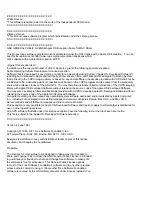
Storage Management Overview
56
NAS 4000s and 9000s Administration Guide
Fault-Tolerance Methods
Different RAID (redundant array of independent disks) types use different methods of striping
the arrays and different ways of writing data and parity to the drives to offer a variety of fault
tolerance and capacity usage. The RAID methods supported by the NAS server include:
■
RAID 0—Data Striping only, no fault tolerance
■
RAID 1+0—Drive Mirroring and striping
■
RAID 5—Distributed Data Guarding
■
RAID ADG—Advanced Data Guarding (ADG)
Further protection against data loss can be achieved by assigning an online spare to an array.
This hard drive contains no data and is contained within the same storage subsystem as the
other drives in the array. When a hard drive in the array fails, the controller can then
automatically rebuild information that was originally on the failed drive onto the online spare.
This quickly restores the system to full RAID level fault tolerance protection.
Note:
The ADG feature is available only with the MSA1000. RAID 5DP is available only with HP
Virtual Arrays and is equivalent to ADG.
These fault tolerance methods are discussed in the following paragraphs.
RAID 0—Data Striping
This configuration provides striping of the array to improve read and write performance, but
offers no redundancy of data and therefore no protection against data loss when a drive fails.
However, RAID 0 is useful for rapid storage of large amounts of noncritical data (for printing
or image editing, for example) or when cost is the most important consideration.
When creating RAID 0 arrays, carefully consider how many drives to include in the array.
Statistically, the chance of a drive failure increases with each additional drive that is included
in an array. Based upon laboratory testing, HP recommends including no more than 7 drives in
a RAID 0 array.
See
Figure 26
for an illustration of the data striping technique.
Advantages
■
Highest performance method for reads and writes
■
Lowest cost per unit of data stored
■
All drive capacity is used to store data; none is used for fault tolerance
Disadvantages
■
All data on logical drive is lost if a hard drive fails
■
Cannot use an online spare
■
Data can only be preserved by being backed up to external media
Summary of Contents for NAS 4000s
Page 18: ...About this Guide 18 NAS 4000s and 9000s Administration Guide ...
Page 92: ...Disk Management 92 NAS 4000s and 9000s Administration Guide ...
Page 196: ...NetWare File System Management 196 NAS 4000s and 9000s Administration Guide ...
Page 246: ...Index 246 NAS 4000s and 9000s Administration Guide ...
















































